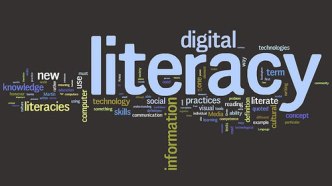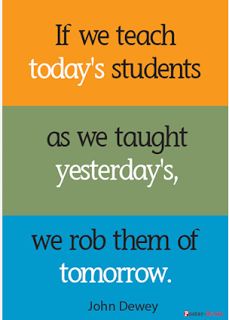Introduction
Technology has the ability to transform how children learn, though it could be argued in many primary school settings technology is not being utilised to its full potential. Historically schools taught handwriting as it was a skill required for future employment and children were required to solve math manually as this was the only way. However, basic skills of reading, writing and mathematics are no longer enough and children do not need this out-dated system. It could be suggested the old system is struggling to engage a new generation of students for whom learning is continuously happening online, off line and in the classroom. In accord with this, educationalist and author Marc Prensky (2013) claims the curriculum and theory have changed very little since Victorian time, he goes on to say,
“We need a new curriculum (…) we are going to have to create the education of the future because it doesn’t exist anywhere today (…) a whole new core of subjects is needed, focusing on the skills that will equip today’s learners for tomorrow’s world of work” (Prensky, 2013: online).
These skills include problem-solving, creative thinking and collaboration. Similarly, Sugata Mitra (2015) a professor from Newcastle University argues, the system is producing identical people for a machine that no longer exists. Consequently, in a technology driven society one could question how present day schooling is preparing students for the future.
The following video emphasizes the assertions of this introduction.
This interactive essay aims to analyse the use of technology in primary school classrooms. It will first consider the recent changes to the curriculum and then it will discuss digital literacy and critical thinking in primary school settings. This will include whether Howard Rheingold’s Crap Detection would aid children with new skills such as searching for the ‘authority of the text’ thus allowing them to become critical thinkers.
The National Curriculum
The National Curriculum (2013) states high quality computing education will ensure pupils are taught a range of computing skills that will equip them with the foundational knowledge and understanding needed to participate in this digital world. Furthermore, former education secretary Michael Gove (2014) asserts the new computing curriculum allows teachers and schools more freedom, and so teachers are not to just equip students with computer skills, but inspire them.
Despite the replacement of the old ICT teacher training schemes with the new computer science ITT courses, it has been criticised that technology is not becoming sufficiently embedded in classroom practice. According to Schleicher (2015: 150) “schools and education systems are on average, not ready to leverage the potential of technology”. Therefore teachers may not be integrating technology in their teaching as many remain uncertain about its benefits and importance. Complementary to this, Patterson (2015) reported that the majority of schools lack access to the right technology and support in order to get the best from it. He further claims that teachers report technology is more often a disrupter then an enabler of teaching and learning in the classroom.
The National Curriculum (2013) also states children should be taught internet safety, responsibility and acceptable online behaviours , so this leads to the next part of the essay.
 The core of computing is computer science which allows children the opportunity to be taught how digital systems work and how to put this knowledge to use through programming (National Curriculum, 2013). Therefore it could be disputed the new curriculum teaches precisely the sort of skills which the jobs of the future demand. This has been criticised by Fernando (2016) – the founder of digital transformation company Freeform, as he argues that coding is a useful skill, however the emphasis is on process rather than meaning, so it is not enough to develop the minds of children. Interestingly Jones (2013) claims computing ensures that pupils become digitally literate. But how does one define digital literate? According to the National Curriculum (2013: online);
The core of computing is computer science which allows children the opportunity to be taught how digital systems work and how to put this knowledge to use through programming (National Curriculum, 2013). Therefore it could be disputed the new curriculum teaches precisely the sort of skills which the jobs of the future demand. This has been criticised by Fernando (2016) – the founder of digital transformation company Freeform, as he argues that coding is a useful skill, however the emphasis is on process rather than meaning, so it is not enough to develop the minds of children. Interestingly Jones (2013) claims computing ensures that pupils become digitally literate. But how does one define digital literate? According to the National Curriculum (2013: online);
“Digitally literate is the ability to use and express themselves and develop their ideas through information and communication technology- at a level suitable for the future workplace, and as active participants in a digital world”.
Complementary to this, Hague and Payton (2010) assert that digital literacy includes critically engaging with technology and developing social awareness. In short, “digital literacy allows young people to participate meaningfully and safely as digital technology becomes ever more pervasive in society” (Hague and Payton, 2010: online). Thus, it could be suggested digital literacy is an important entitlement for all young people in an increasingly digital culture. However, the notion of digital literacy and how it may translate to teaching and learning is not always well understood. Jones (2013) claims is it a challenge to assess computing as teachers find is hard to judge pupils knowledge and understanding based on the outcome of practical tasks. Working collaboratively results in the teacher unable to identify each individual’s contribution.
Perhaps digital literacy in the classroom could provide pupils with the opportunity to become more involved in their learning. For instance, peer assessment and evaluation could be helpful in assessing digital literacy as this allows learners to participate in their own assessment, thus creating an effective way to encourage reflection. Furthermore, digital literacy allows learners to become active constructors of knowledge in the classroom which suggest a different role for the teacher, that of a facilitator. Similar to the constructivist theory in which a teacher becomes a facilitator and cognitive guide, promoting the use of group discussion and collaboration. Working collaboratively in small groups is an obvious constructive approach to learning and the advantage of group discussion is highlighted by Piaget and Vygotsky (1978: cited in Galloway, 2001) who placed emphasis on the social nature of learning. As students engage with others they construct new knowledge and develop critical thinking skills to seek answers. The following video highlights the importance of Digital Literacy
Subsequently, a digital literate student is not just passively receiving information but also contributing to its analysis of it. Hague and Payton (2010) pointed out that this requires critical thinking.
“If we teach children to read and write, provide them with factual information, but do not equip them with the cognitive skills to understand, appreciate, transfer or connect ideas, then the information they have may be meaningless in the future” (Hague and Payton, 2010: 38)
However, encouraging and developing critical thinking requires time for thoughts and questions, something that maybe difficult due to the constraints of the overwhelming curriculum. Yet Paulo Freire strongly argued children should be learning critically, continuously reflecting with an open mind-set and a sense of mission. It could be suggested detached coding lessons cannot create this enthusiasm. Fernando (2016) asserts that schools should give children the critical thinking skillset that will allow them to become future engineers.
If a child is not taught to think critically then how can they be expected to use the internet safely? Perhaps the use of Howard Rheingold’s Crap Detection 101 could be of great use to children and further develop their critical thinking skills.
Crap Detection
Interestingly, in ‘How to thrive online’ Rheingold (2012) wrote that teaching children to evaluate creditability and information will result in them being more cautious about trusting strangers. Rheingold (2012) criticises current curriculum and questions how classrooms and schools can be reformed enough so that critical and lively people can be nurtured there? It is apparent there is an inconsistency of teaching approaches and strategies regarding online safety and so schools need to ensure children from a young age are given the opportunity to develop appropriate technical and social skills. Complementary to this Henderson (2013) claims ensuring young people have the knowledge to operate safely online will develop their critical understanding of the online environment.
A simple acronym for children to follow is an effective way for schools and teachers to develop children’s critical thinking skills, thus improving their internet safety awareness knowledge.
Conclusion

Many children are surrounded by technology from a young age, so is it fair to expect children to engage in a lesson with such a lack of technology when in their everyday life’s they Care constantly surrounded by digital technologies? Technology today can provide a great quantity of information for children, yet it is important that schools allow children to develop their critical thinking skills from a young age so children can determine the good information and the poor information. It is apparent that allowing teachers to become facilitators in the process could result in children generating their own knowledge. Through analysing, questioning and evaluating information children can find answers and make an informed opinion. As identified by Rheingold (2012), if schools taught children a literacy skill to determine the creditability of information found on the internet then the more successful they will likely be. Perhaps increasing the number of people who can distinguish bad information from good information could result in an improved internet experience for everyone.
Plagiarism & Copyright
With any academic work it is essential to consider plagiarism. However, because this is an interactive essay which incorporates digital technologies it is also important to consider copyright issues. Plagiarism is defined as “passing off” someone else’s work as one’s own whereas copyright is a legal concept, providing the creator of the original work exclusive rights to it. In both cases the creator has the right to be credited or recognised for their work.
In this essay the authors have been cited and listed in the reference list. According to Bielefeld and Cheesemen (2007) citing sources and engaging in conversation adds strength to an essay and demonstrates the student’s awareness of plagiarism. It is important to note in this interactive essay, videos such as Marc Prensky and Sugata Mitra are hyperlinked to reference these sources. Information from videos should be considered the same as any other sources which are used for academic purposes. As discussed previously, this relates back to Howard Rheingold’s Crap Detection where the acronym ‘CRAP’ can be applied, enabling students to detect credible sources.
Similarly, the videos in the essay have also been listed in a reference list. However, when people publish their videos on YouTube they are given the option to enable or disable the share button for their video. Therefore if they choose to share their video they provide the HTML code, thus allowing others to use their video. Yet, it could be disputed not everyone is ‘knowledgeable’ regarding copyright issues.
References
Bielefeld, A and Cheesemen, L. (2007). Technology and Copyright Law: a guidebook for the library. research and teaching professions. New York. Schumann Publishers.
Fernando, G. (2016). Coding lessons are good, but not enough. We need the next generation of Brunels, too. Available Online at: https://www.tes.com/news/school-news/breaking-views/coding-lessons-are-good-not-enough-we-need-next-generation-brunels.
Galloway, C, M. (2001). Emerging Perspectives on Learning, Teaching and Technology. Department of Educational Psychology and Instructional Technology Teaching. University of Georgia.
Gove. M. (2014) Michael Gove Speaks about Computing and Education Technology. Available Online at: https://www.gov.uk/government/speeches/michael-gove-speaks-about-computing-and-education-technology.
Hague, C, and Payton, S. (2010). Digital Literacy Across The Curriculum. Futurelab. Bristol.
Henderson-Martin, H. (2013) Experiences of e-safety within primary school education. In: ICERI2013 Proceedings. Seville, Spain: International Academy of Technology, Education and Development (IATED). 9788461638475 / ISSN: 2340-1095. pp. 4202-4207.
Jones, P, S (2013). Computing in the National Curriculum: a guide for primary teachers. Computing at School Educate. Engage. Encourage. In collaboration with BCS, The Chartered Institute for IT COMPUTING AT SCHOOL EDUCATE • ENGAGE • ENCOURAGE In collaboration with BCS, The Chartered Institute for IT.
National Curriciulum. (2013). National Curriculum in England, Computing Programs of Study. Available Online at: https://www.gov.uk/government/publications/national-curriculum-in-england-computing-programmes-of-study.
Patterson, G. (2015). Cracking the tech literacy challenge: crowdsourcing ideas to help build a culture of tech literacy for the nation. British Tele Communication Plc. Available Online at: http://www.home.bt.com/pages/techliteracy/BT_Tech_Literacy.pdf.
Rheingold, H. (2012). How to Thrive Online. The MIT Press. Cambridge, Massachusetts, London, England. Available Online at: http://www.google.co.uk/url?sa=t&rct=j&q=&esrc=s&source=web&cd=4&ved=0ahUKEwiUqsr05dTLAhVD8RQKHV08DHQQFggsMAM&url=http%3A%2F%2Fhci.stanford.edu%2Fcourses%2Fcs047n%2Freadings%2Frheingold-net-smart.pdf&usg=AFQjCNF9lyBB-DlS67hyffocUFRNDUeVkg&sig2=dPXZMYqAWkZQOUpZBF_GGA.
Schleicher, A. (2015). Students, Computers and Learning: Making the Connection. PISA, OECD Publishing. Available Online at: http://dx.doi.org/10.1787/9789264239555-en
Digital Video References
EF Explore America. (2012). What is 21st Century Education?. [Online Video]. 15/03/2012. Available from: https://youtu.be/Ax5cNlutAys. [Accessed: 11 March 2016].
Howard Rheingold. (2011). Crap Detection 101. [Online Video]. 17/02/2011. Available from: https://youtu.be/AHVvGELuEqM. [Accessed: 01 March 2016].
Learning for the 21st Century. (2012). Use a Learning Theory: Constructivism. [Online Video]. 30/12/2012. Available from: https://youtu.be/Xa59prZC5gA. [Accessed: 07 March 2016].
Marc Prensky. (2014). The World Needs a New Curriculum. [Online Video]. 23 October. Available from: https://youtu.be/FmNPPYFYWoI. [Accessed: 22 March 2016].
Mark Heninger. (2013). Why Our Kids Must Learn to Code. [Online Video]. 01/03/2013. Available from: https://youtu.be/STRPsW6IY8k. [Accessed: 02 March 2016].
Sugata Mitra. (2013). TED 2013 Winning Talk. [Online Video]. 28/02/2013. Available from: https://youtu.be/zpcEpmNbHds?list=PL84b1TR9XxFktBIyj82uXDaWcOYCJYIxh. [Accessed: 15 March 2016].
TED Talks Joe Ruhl. (2015). https://youtu.be/UCFg9bcW7Bk. [Online Video]. 27/05/2015. Available from: https://youtu.be/Ax5cNlutAys. [Accessed: 11 March 2016].
University of Derby. (2014). Digital Literacy and Why it Matters. [Online Video]. 05/11/2014. Available from: https://youtu.be/p2k3C-iB88w. [Accessed: 09 March 2016].
